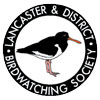LDBWS Field Meeting: Sunderland Point and Middleton Sands
This lovely area is one of our district's very best autumn birding spots, with visible migration of finches, wagtails, thrushes, pipits and larks often a morning feature. Scarcities in the fields and bushes here have included Lapland Bunting, Yellow-browed Warblers and Siberian Chiffchaffs in recent Octobers. Most of these migrants are weather-dependent (!) but whatever
